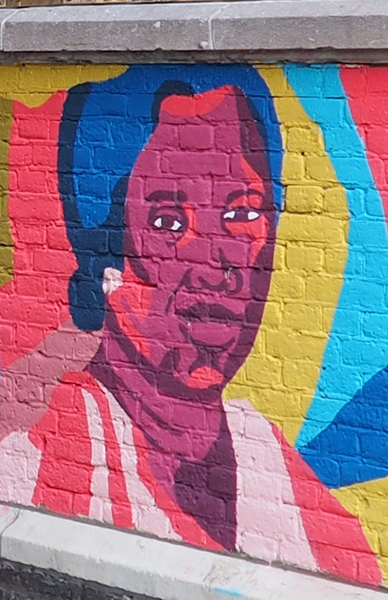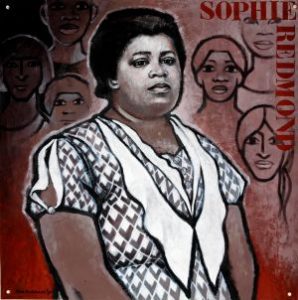A blog about (hidden) Amsterdam
A blog about (hidden) Amsterdam
“The Wall of Surinamese and Black Heroes” is a beautiful mural by Hedy Tijn & Dewy “Butterfingaz” Elsinga at the entrance to the Black Archives at the Hugo Olijfveldhuis. We want everyone to know their stories. Up next is early female doctor, playwright, actress, activist, and community leader Dr. Sophie Redmond.

Jeanne Sophie Everdine Redmond was born in 1907 in Paramaribo, the capital of Suriname. Her father was a schoolteacher who wanted his daughter to follow in his footsteps. At the time, being a teacher was the highest professional achievement available to a dark-skinned woman in colonial Suriname. He was extremely concerned when she announced she was going to med school – and not without reason.
She had to fight just to get admitted and the school administration initially rejected her application. Once she got them to admit her, she faced all of the financial and academic challenges alone. The best she could hope for from classmates and teacher was indifference – and she often didn’t even get that. Despite the insults and obstacles, she became the fifth woman to graduate and the first Creole woman.
In fact, her culture was a huge part of her life. As with any culture, it’s difficult to succinctly describe and made more confusing by the fact that various countries and languages use the word Creole in very different ways. Broadly, Surinamese Creole culture is created by formerly enslaved people and their descendants with some elements passed down from their African cultures of origin, some Dutch-inflected elements, and some elements that are uniquely, joyfully Surinamese.
One such element is Sranantongo, a language that combines English and Dutch elements. When Dr. Redmond was in school, this language was spoken by a large part of the population, but never used in official documents or addresses. That was one of many trends Dr. Redmond would defy.

As she built her practice amongst the poor, she offered her patients advice as well as healthcare. She advised them on wellness, as well as marital, family, household, and financial issues. Eventually, she developed this into a radio program in Sranantongo, where she would offer medical lessons from her practice and respond to letters requesting advice.
She also used Sranantongo in the theater she helped create, both as a performer and a writer. It began with universal suffrage in 1948. She performed in a farce that she may also have cowritten that contained information about voting. She wrote and performed in several more than entertained and shared information, both about health practices and about the living conditions in Suriname.
She also became a more outspoken champion of Creole culture. She wore a koto, a type of beautifully colored traditional garment, and organized koto shows to draw attention to the style. She focused on native foods and dishes in her talks and refused to buy imported fruits. When she died at age 48, she was in the process of undertaking a systematic survey of the properties of Surinamese healing herbs.
One source said that “she died while still full of plans”. I think the other side of that sentence is that her life was full of not only plans but actions. It is the rare person who has both the creativity to see new ideas and the determination to convert them into action, regardless of the obstacle. Dr. Sophie Redmond did the concrete work of treating her patients’ bodies while building the ideas to heal their spirits.
We hope you’ll join us someday on our Hidden Gems Tour, where you can learn about more incredible people like Sophie Redmond.
Check out some more Blamsterdam! posts.
Private Museum Tour
See the highlights and hidden icons of Amsterdam’s world-renowned Rijksmuseum in a private guided tour that explores who creates art and what stories it’s used to tell. And don’t worry about museum tickets. We’ve got you covered.


Small-Group Walking Tour
This historical tour through the busy Jewish quarter and residential Plantage neighborhood offers a selection of stories from BIPOC, LGBTQ+, Jewish and women’s history. It’s the perfect way to get an alternative view of Amsterdam.


Self-Guided Digital Tour
Use your phone to explore Amsterdam! This self-guided tour uses audio, images, maps, and text to introduce you to the women, BIPOC, LGBTQ+, and Jewish people who made Amsterdam what it is.


Small-Group Walking Tour
In 1593, Jewish Amsterdammers began building a community in the relative safety of the city that transformed both the Netherlands and the world. Learn about these creative, compassionate, and challenging mavericks and their impact.


Small-Group Walking Tour
The women who shaped Amsterdam are more complex than traditional tours would have you believe. Go to Amsterdam’s historic sites to hear stories of women who fought, wrote, calculated and led through the city’s chaotic and complicated past.


Small-Group Walking Tour
The world’s first gay marriage was officiated by the Mayor of Amsterdam at its City Hall. But did you know that the city’s LGBTQ+ history stretches centuries? Meet historical Amsterdammers across the gender spectrum and sexual orientations.


Private Walking Tour
Get a personalized tour that covers the interests you’re curious about and the neighborhoods you want to see. Choose pick-up/drop-off locations, any combination of our hidden history topics, and themes such as artists, politicians, and rebels.

